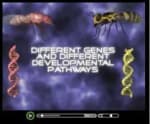Evidence For Evolution
(Read Evidence For Evolution, Part 1 First)
Evidence for Evolution - The Stanley Miller Experiment:
(ex) The Stanley Miller "Spark and Soup" experiment produced amino acids building blocks. Evidence for the spontaneous generation of life from inorganic matter "naturally by random chance" in the laboratory? (crit) No! There are three problems with Miller's experiment. He started with the wrong materials, used the wrong conditions, and got the wrong results! (Mark Eastman, M.D., "Creation by Design," 1996, pp. 15-19.) The truth is, the DNA molecule is so complex that today's biochemists using today's biochemical know-how (under the supposed conditions found upon the early earth) cannot so much as produce its protein building blocks. Furthermore, the genetic code inherent to the DNA molecule is a digital, error-correcting, redundant, over-lapping, information storage and retrieval system with its own inherent language convention! Information science has shown that both language conventions and such incredible digital information storage and retrieval systems can only be the product of intelligent design. (Mark Eastman, M.D., Chuck Missler, "The Creator Beyond Time and Space," 1996, pp. 83-102.) To believe life could be the product of random chance (as supposed by Darwinian evolution) is to swim against the tide of modern empirical science.
Evidence for Evolution - The Peppered Moth Experiment:
(ex) Photographs of peppered moths naturally camouflaged while at rest upon tree trunks as evidence for natural selection. (crit) Biologists have known since the 1980's that peppered moths don't normally rest on tree trunks. The photographs found in the textbooks were staged using dead moths glued to tree trunks. (Jonathan Wells, Ph.D., "Second Thoughts about Peppered Moths," 1999: http://www.arn.org/docs/wells/jw_pepmoth.htm.)
Evidence for Evolution - Genetic Mutations:
(ex) Genetic mutations have been shown to cause variation within species. (crit) Genetic mutations result in a net loss of genetic information. There is no naturalistic source for genetic information (nor is there a naturalistic explanation for the existence of information). Genetic mutation simply causes existing genetic information to become corrupted - genetic mutations follow a downward trend. For example, it is universally agreed that wolves, coyotes, dingoes, jackals, foxes, and the hundreds of different domestic dog breeds probably all came from an original pair of "dogs". This is "Variation within a Kind," NOT upward evolution from simplicity into complexity as supposed by Darwin's theory of evolution. The variations are always in a downward trend constrained by the genetic code (the dogs do not grow wings and learn to fly). No new genetic information is added, genetic information is always lost: the original pair of "dogs" had all of the potential characteristics of all their various progeny, while the descendants themselves have lost that same potential.
Evidence for Evolution - Vestigial Organs:
(ex) Body parts thought to be useless remnants of past evolutionary development. (crit) Back in 1895, Robert Wiedersheim listed 180 alleged vestigial organs. This list included: tonsils, coccyx (tail bone), thymus, little toe, male nipples, ear nodes, pineal gland, adenoids, appendix, wisdom teeth, parathyroid, ear muscles, body hair, and the nictitating membrane of the eye. Since the compilation of Wiedersheim's list at the end of the 19th century, we have discovered important biological functions for every one of these so-called vestigial organs. Roy Hartenstein comments on the human appendix: "Long regarded as a vestigial organ with no function in the human body, the appendix is now thought to be one of the sites where immune responses are initiated." (Grolier Encyclopedia, 1998.) Circumstances may arise at which point it would be better to risk the consequences of removing the appendix rather than risk keeping it. Nevertheless, it is not a useless vestige from our evolutionary past. Dr. Walt Brown writes concerning vestigial organs in general, "The existence of human organs whose function is unknown does not imply they are vestiges of organs inherited from our evolutionary ancestors. As medical knowledge has increased, at least some functions of all organs have been discovered." (Walt Brown, "In the Beginning," 2001, p. 9.)
Besides these human vestigial organs, examples of nonhuman vestigial organs given in the textbooks are very misleading. Consider the "whale pelvis" for example. Kids are not told that the whale pelvis is necessary for muscle attachments, without which the whale could not reproduce.
Evidence for Evolution - Where is it?
So where is the so-called evidence for evolution? Not in the biology textbooks used in the public schools! Aren't there any legitimate evidences for the theory? Why do we have to imagine macro-evolution happening "long ago and far away..."? Could undirected natural processes alone assemble the intricate structures found within living cells? Can chemistry alone account for the origin of life on earth? What is the origin of the genetic information encoded in living organisms? Until evolutionists come up with real answers to these fundamental questions, Darwinian evolution should be kept in philosophy textbooks where it belongs and taken out of biology textbooks where, tragically, it has become entrenched.
Where is it?


